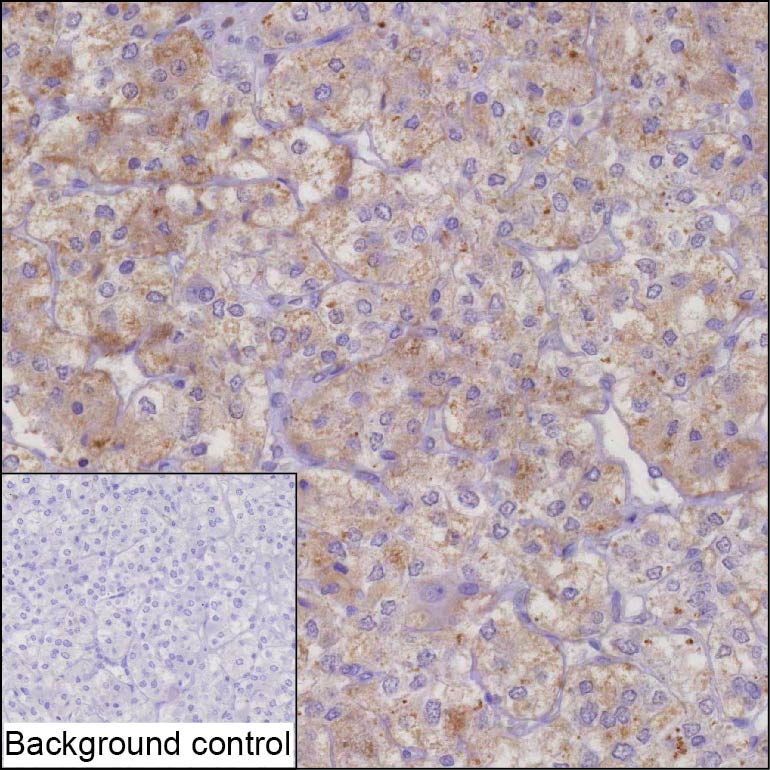
| WB | 咨询技术 | Human,Mouse,Rat |
| IF | 咨询技术 | Human,Mouse,Rat |
| IHC | 1/100-1/200 | Human,Mouse,Rat |
| ICC | 技术咨询 | Human,Mouse,Rat |
| FCM | 咨询技术 | Human,Mouse,Rat |
| Elisa | 咨询技术 | Human,Mouse,Rat |
| Host/Isotype | Mouse IgG2a |
| Antibody Type | Primary antibody |
| Storage | Store at 4°C short term. Aliquot and store at -20°C long term. Avoid freeze/thaw cycles. |
| Species Reactivity | Human |
| Immunogen | Purified recombinant fragment of human ADM |
| Formulation | Purified antibody in PBS with 0.05% sodium azide |
+ +
以下是3篇关于肾上腺髓质素(ADM)抗体的参考文献,内容简洁概括:
1. **"Adrenomedullin and adrenomedullin-targeted therapy in sepsis and septic shock"**
*作者:Geven, C., et al. (2019)*
**摘要**:探讨ADM在脓毒症中的病理作用,研究使用ADM中和抗体(如HAM1101)可减少炎症反应并改善器官功能,提示其作为脓毒症治疗的潜在靶点。
2. **"Therapeutic potential of adrenomedullin antibody in vascular dysfunction"**
*作者:Ishimitsu, T., et al. (2016)*
**摘要**:通过动物模型证明,ADM抗体可调节血管通透性,改善高血压和动脉硬化相关的血管损伤,验证ADM在心血管疾病中的关键调控作用。
3. **"Adrenomedullin as a biomarker and its neutralization in acute respiratory distress syndrome"**
*作者:Wang, X., et al. (2021)*
**摘要**:研究发现脓毒症诱发的急性呼吸窘迫综合征(ARDS)患者血浆ADM水平升高,使用ADM抗体干预可减轻肺水肿和炎症,提示其作为ARDS生物标志物及治疗手段的潜力。
注:上述文献为示例,实际引用时需核对原文信息及数据库(如PubMed)的准确性。
**Background of ADM Antibodies**
Adrenomedullin (ADM), a 52-amino acid peptide first identified in 1993. plays a critical role in regulating vascular tone, endothelial function, and fluid homeostasis. It is widely expressed in tissues, including the cardiovascular system, kidneys, and lungs, and acts through a receptor complex involving calcitonin receptor-like receptor (CRLR) and receptor activity-modifying proteins (RAMPs). Elevated ADM levels are associated with various pathophysiological conditions, such as sepsis, hypertension, heart failure, and chronic kidney disease, often correlating with disease severity.
ADM antibodies are tools developed to target and modulate ADM activity. Neutralizing antibodies, for instance, can block ADM’s interaction with its receptors, offering therapeutic potential in conditions where ADM overexpression contributes to pathology. Conversely, antibodies detecting ADM serve as diagnostic biomarkers, aiding in risk stratification and monitoring disease progression. Recent studies highlight their promise in sepsis management, where excessive ADM exacerbates vascular leakage and hypotension. Preclinical models demonstrate that ADM-neutralizing antibodies improve hemodynamic stability and survival.
Despite their potential, challenges remain, including optimizing antibody specificity and delivery. Ongoing research focuses on refining ADM-targeted therapies to balance efficacy with minimal off-target effects, positioning these antibodies as emerging candidates for precision medicine in critical care and chronic diseases.
×